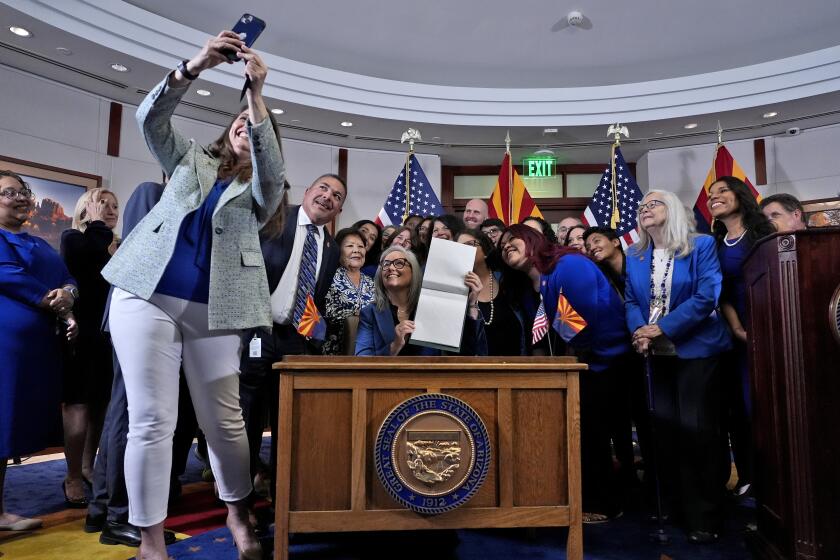Lawmakers are putting economic recovery at risk
Seldom has the policy conflict between recovery and reform been presented as starkly as in the last two weeks.
On the one hand, there is last week’s congressional agreement on a historic reshaping of the financial regulatory system — which brings stronger consumer protections, sharper oversight of mega-banks and risk-oriented behavior, new constraints on mortgage terms and closer scrutiny of credit rating agencies and insurance companies.
On the other, there’s the failure of Congress (thanks to the threat of a Republican filibuster in the Senate) to extend unemployment coverage for more than 1 million Americans and to provide about $24 billion in Medicaid assistance for state budgets. That places as many as 900,000 public- and private-sector jobs, not to mention crucial services for destitute residents, at risk.
Not helping matters was the noise coming from last weekend’s G-20 summit of developed countries in Toronto about the need to cut fiscal deficits by 2013.
Plainly, while reform is beginning to move ahead, economic recovery is still very much at risk. The main threat comes from short-sighted policymakers who, despite an abundance of evidence that growth remains dependent on continued fiscal stimulus, have become unduly enamored of austerity instead.
There’s no question that the stimulus already in the system has pulled the world economy back from the brink. “We’re in a very different place than we were a year ago,” Lawrence H. Summers, director of President Obama’s National Economic Council, said last week in a conversation in his West Wing office with a group of us from The Times. “A year ago the question was about a free fall, it was about depression. Today the questions are about the pace of recovery. That’s a much better kind of question to hear.”
He added: “We’ve begun the process of turnaround. The challenge going forward is to maintain and accelerate momentum.”
It’s important to note that the momentum of which he spoke is fragile in the extreme. Gross domestic product is rising, but the annual growth rate in the first quarter of this year, 2.7%, is slower than that of the previous quarter (5.6%). It’s also slower than the rate needed for job growth to keep pace with population growth (3%) or the 5% needed to bring down the unemployment rate, which is 9.7%.
The economy has added jobs since the beginning of the year, but employment in May was still below the level of May 2009.
How important is government stimulus? The modest job growth this year incorporates a large component of government hiring — the increase of 431,000 in nonfarm employment in May, according to the Bureau of Labor Statistics, included 411,000 temporary workers hired for the 2010 census. And although home prices have stabilized in much of the country, new-home sales collapsed by 33% in May, following the April 30 expiration of a federal tax credit for home purchasers.
It’s not as though the economy didn’t face enough crosswinds already. Long-term unemployment has become “a particularly disturbing feature of this recession,” Summers says.
“There is evidence that people who have been out of work for a year tend to have a difficult time returning and often drop out of the labor force,” he says. “That is going to cast a shadow for some significant interval.”
Nor has there been a reversal in the trend toward increasing income inequality in the United States. In 1979, the top 1% of U.S. households earned eight times as much as the middle 20% and 23 times as much as the bottom fifth; by 2005, the Congressional Budget Office found, the upper crust touched 21 times as much as the middle class and 70 times as much as the bottom.
This phenomenon “has a broadly corrosive social impact in terms of our not being one America,” said Summers, echoing the economist Benjamin M. Friedman, who observed in 2006 that the 1950s and ‘60s, when median family income doubled, brought us such progressive social developments as the civil rights movement.
Over the succeeding decades the social fabric has frayed, Friedman wrote. Public opinion has turned sharply against immigration and affirmative action, and attacks on welfare recipients display “a vindictive spirit that was highly uncharacteristic of the United States in the postwar era.”
Things may be headed downward from here. The death last week of a $100-billion jobs and economic relief bill will place unimaginable strain on state and local budgets, provoking cuts that may well undo all the progress that was made under last year’s $787-billion stimulus package.
That package, according to an analysis by the California Budget Project, provided $85 billion in funds for California alone. It helped lawmakers in Sacramento close the last budget gap by increasing federal funding for Medi-Cal — relieving pressure on the state budget while restricting cuts in eligibility, thereby safeguarding coverage for many low-income Californians.
Yet Congress’ action pulls the rug out from the residents of California and other states. The Washington-based Center on Budget and Policy Priorities found that 33 states and the District of Columbia had enacted budgets incorporating, directly or indirectly, money they expected from the bill. That doesn’t include California, where Gov. Schwarzenegger said earlier this year his 2010-11 budget proposal assumed an inflow of $1.8 billion in Medicaid/Medi-Cal funding — which has been, for now, extinguished.
The state budget reductions, wage cuts, furloughs and layoffs that will be made necessary by Congress’ dereliction will drive up unemployment, erode consumer demand and intensify doubts about the strength of the recovery.
What is the source of the deficit panic that’s fueling the pushback on economic stimulus? It’s certainly not the public’s conviction that government assistance is no longer needed. It’s hard to identify a widespread perception that the economy has turned up, although Summers argues that such perception always lags behind reality.
“Recoveries are more like rheostats than light switches,” he said. “People are gradually getting the sense of improvement. But it won’t feel like everything is better all of a sudden. It will take time.”
Is it bond investors fearful that deficit spending will drive up long-term interest rates, harming their portfolios, as the economist Paul Krugman posits? Or is it someone’s Machiavellian effort to prove the correctness of Keynesian economics, which supports heavy government stimulus in periods when the private sector withdraws from investment, by imposing anti-Keynesian stimulus cuts while they’re still needed?
John Maynard Keynes, it should be noted, was unafraid of government deficits. “At the present time, all governments have large deficits,” he wrote in 1931, as his biographer Robert Skidelsky observed recently. “They are nature’s remedy for preventing business losses from being ... so great as to bring production altogether to a standstill.”
A few years later, Franklin D. Roosevelt bowed to his era’s deficit hawks and cut back on federal programs to bring the federal budget more into balance. He got the recession of 1937 for his pains.
The deficit-cutting craze of the modern day threatens another such double dip. Its promoters say they’re out to protect long-term economic prospects, but without a short-term recovery there may not be a long term to protect. If they get their way, we may not feel the consequences of their error before it’s too late to fix.
Michael Hiltzik’s column appears Sundays and Wednesdays. Reach him at mhiltzik@latimes.com, read past columns at https://www.latimes.com/hiltzik, check out https://www.facebook.com/hiltzik, and follow @latimeshiltzik on Twitter.
More to Read
Get the L.A. Times Politics newsletter
Deeply reported insights into legislation, politics and policy from Sacramento, Washington and beyond. In your inbox three times per week.
You may occasionally receive promotional content from the Los Angeles Times.











